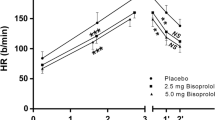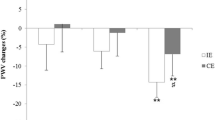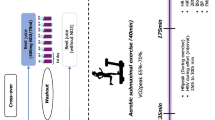Abstract
Summary. Recent studies have questioned the safety of calcium antagonists in general, and short-acting dihydropyridine derivatives in particular. Reasons include excessive catecholamine stimulation after stress. We therefore wanted to assess whether amlodipine, a second generation dihydropyridine with a prolonged plasma half-life, would show a more favourable haemodynamic and biochemical profile after strenuous exercise. For this purpose, we studied 9 healthy volunteers in a double-blind, randomized, placebo-controlled trial. After 10 days of amlodipine, 5mg orally daily or placebo therapy, volunteers performed a treadmill effort test; the sequence was repeated after a 2-week washout period. Amlodipine caused a significant increase in mean resting heart rate (HR) (from 65 ± 3 to 70 ± 3 beats/min, p < 0.05), without changing systolic or diastolic blood pressure (SBP, DBP). Post-exercise haemodynamic responses were similar while on amlodipine or placebo therapy. Amlodipine did not alter the normal profile of resting or exercise-induced metabolic [plasma glucose, serum K+, serum free fatty acid (FFA)] and hormonal [plasma cortisol, growth hormone, prolactin, insulin, epinephrine (EPI) and norepinephrine (NE)] responses—although plasma EPI concentrations dropped significantly lower (p < 0.05) at 5 min and 15 min post-exercise while on the calcium antagonist. We conclude that amlodipine has a largely neutral effect on the physiological profile after brisk exercise in healthy young subjects and that this may prove to be a useful property for a vasodilator drug.
Similar content being viewed by others
References
Chalmers J, Zanchetti A. The 1996 report of a World Health Organization expert committee on hypertension control. J Hypertens 1996;14:929–33.
Metha JL, Lopez LM. A double-blind evaluation of amlodipine in patients with chronic, stable angina: Sustained efficacy and lack of ‘withdrawal phenomenon’ upon abrupt discontinuation. Clin Cardiol 1994;17:17–22.
Joffe BI, Shires R, Lamprey JM, et al. Nifedipine does not impair the hormonal response to exercise in healthy subjects. Hormone Res 1985;21:88–94.
Agabiti-Rosei E, Muiesan ML, Romanelli G, et al. Similarities and differences in the antihypertensive effect of two calcium antagonist drugs, verapamil and nifedipine. J Am Coll Cardiol 1986;7:916–924.
Klug EQ, Joffe BI, Panz VR, Meyer TE, Fine BJ, Seftel HC. Perindopril and physiologic responses to exercise. J Cardiovasc Pharmacol 1994;23:864–868.
Psaty BM, Heckbert SR, Koepsell TD, et al. The risk of myocardial infarction associated with antihypertensive drug therapies. JAMA 1995;274:620–625.
Opie LH. Calcium channel blockers for hypertension: Dissecting the evidence for adverse effects. Am J Hypertens 1997;10:565–577.
Meredith PA, Elliot HL. Clinical pharmacokinetics of amlodipine. Clin Pharmacokinet 1992;22:22–31.
Shimizu S, Tani Y, Yamada H, Tabata M, Murachi T. Enzymatic determination of serum free fatty acids: A colorimetric method. Anal Biochem 1980;107:193–198.
Lau CP, Cheung BM. Relative efficacy and tolerability of licidipine and amlodipine in patients with mild-to-moderate hypertension: A randomised double-blind study. J Cardiovasc Pharmacol 1996;28:328–331.
Kario K, Shimada K. Differential effects of amlodipine on ambulatory blood pressure in elderly hypertensive patients with different nocturnal reductions in blood pressure. Am J Hypertens 1997;10:261–268.
Goldsmith SR. Effect of amlodipine and felodipine on sympathetic activity and baroreflex function in normal humans. Am J Hypertens 1995;8:902–908.
Vertovec GW, Plumb V, Epstein AE, Kay GN. Evaluation of the acute and electrophysiologic effects of intravenous amlodipine alone and in combination with a beta-blocker in patients with angina pectoris. J Cardiovasc Pharmacol 1993;22(Suppl):S29–S33.
Esler M, Kaye D, Lambert G, Esler D, Jennings G. Adrenergic nervous system in heart failure. Am J Cardiol 1997;80:7L–14L.
Phillips RA, Ardeljan M, Shimabukuro S. Normalization of left ventricular mass and associated changes in neurohormones and atrial natriuretic peptide after 1 year of sustained nifedipine therapy for severe hypertension. J Am Coll Cardiol 1991;17:1595–1602.
Leenen FH, Fourney A. Comparison of the effects of amlodipine and diltiazem on 24-hour blood pressure, plasma catecholamines and left ventricular mass. Am J Cardiology 1996;78:203–207.
Nazzaro P, Manzari M, Merlo M, et al. Antihypertensive treatment with verapamil and amlodipine. Their effect on the functional autonomic and cardiovascular stress responses. Eur Heart J 1995;16:1277–1284.
Hamada T, Watanabe M, Kaneda T, et al. Evaluation of changes in sympathetic nerve activity and heart rate in essential hypertensive patients induced by amlodipine and nifedipine. J Hypertens 1998;16:111–118.
Irving MH, Britton BJ, Wood WG, Padgham C, Carruthers M. Effects of β adrenergic blockade on plasma catecholamines in exercise. Nature 1974;248:531–533.
Klug EQ, Joffe BI. Physiological responses to brisk exercise and the impact of commonly used antihypertensive drugs. Hospital Update 1995;9:35–40.
Paolisso G, Gualdiero P, Manzella D, et al. Association of fasting plasma free fatty acid concentration and frequency of ventricular premature complexes in nonischemic non-insulin-dependent diabetic patients. Am J Cardiol 1997;80:932–937.
Faulkner JK, McGibney D, Chasseaud LF, Perry JL, Taylor IW. The pharmacokinetics of amlodipine in healthy volunteers after single intravenous and oral doses and after 14 repeated oral doses given once daily. Br J Clin Pharmac 1986;22:21–25.
Author information
Authors and Affiliations
Rights and permissions
About this article
Cite this article
Stankovic, S., Panz, V., Klug, E. et al. Amlodipine and Physiological Responses to Brisk Exercise in Healthy. Cardiovasc Drugs Ther 13, 513–517 (1999). https://doi.org/10.1023/A:1007875603969
Issue Date:
DOI: https://doi.org/10.1023/A:1007875603969




